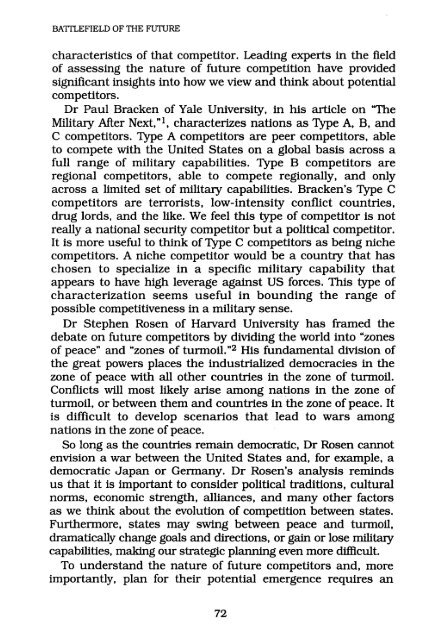BATTLEFIELD OF THE FUTURE
Battlefield of the Future - Air University Press
Battlefield of the Future - Air University Press
Create successful ePaper yourself
Turn your PDF publications into a flip-book with our unique Google optimized e-Paper software.
<strong>BATTLEFIELD</strong> <strong>OF</strong> <strong>THE</strong> <strong>FUTURE</strong><br />
characteristics of that competitor . Leading experts in the field<br />
of assessing the nature of future competition have provided<br />
significant insights into how we view and think about potential<br />
competitors .<br />
Dr Paul Bracken of Yale University, in his article on "The<br />
Military After Next," 1 , characterizes nations as Type A, B, and<br />
C competitors . Type A competitors are peer competitors, able<br />
to compete with the United States on a global basis across a<br />
full range of military capabilities . Type B competitors are<br />
regional competitors, able to compete regionally, and only<br />
across a limited set of military capabilities . Bracken's Type C<br />
competitors are terrorists, low-intensity conflict countries,<br />
drug lords, and the like . We feel this type of competitor is not<br />
really a national security competitor but a political competitor .<br />
It is more useful to think of Type C competitors as being niche<br />
competitors . A niche competitor would be a country that has<br />
chosen to specialize in a specific military capability that<br />
appears to have high leverage against US forces . This type of<br />
characterization seems useful in bounding the range of<br />
possible competitiveness in a military sense .<br />
Dr Stephen Rosen of Harvard University has framed the<br />
debate on future competitors by dividing the world into "zones<br />
of peace" and "zones of turmoil ."2 His fundamental division of<br />
the great powers places the industrialized democracies in the<br />
zone of peace with all other countries in the zone of turmoil .<br />
Conflicts will most likely arise among nations in the zone of<br />
turmoil, or between them and countries in the zone of peace . It<br />
is difficult to develop scenarios that lead to wars among<br />
nations in the zone of peace .<br />
So long as the countries remain democratic, Dr Rosen cannot<br />
envision a war between the United States and, for example, a<br />
democratic Japan or Germany . Dr Rosen's analysis reminds<br />
us that it is important to consider political traditions, cultural<br />
norms, economic strength, alliances, and many other factors<br />
as we think about the evolution of competition between states .<br />
Furthermore, states may swing between peace and turmoil,<br />
dramatically change goals and directions, or gain or lose military<br />
capabilities, making our strategic planning even more difficult .<br />
To understand the nature of future competitors and, more<br />
importantly, plan for their potential emergence requires an<br />
72

















